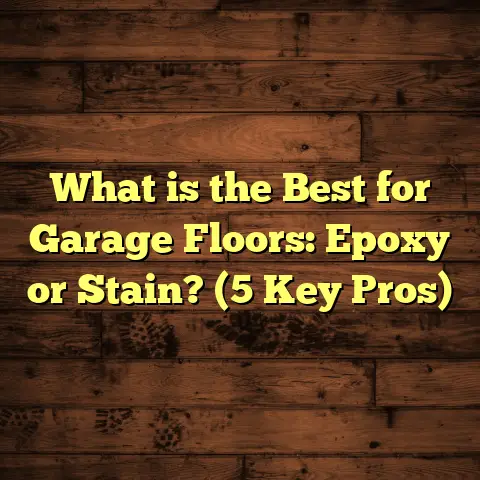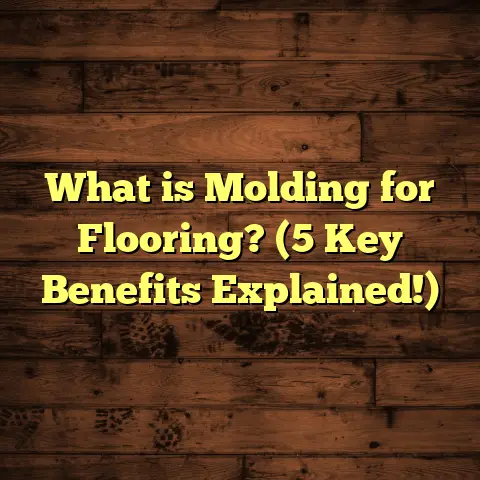What is Dustless Flooring? (5 Reasons to Choose This Trend)
Did you know that indoor air pollution caused by dust from renovation
projects can be up to 10 times higher than outdoor pollution levels? This
shocked me the first time I read about it. Dust isn’t just messy; it’s a
health hazard. Over the years as a flooring contractor, I’ve seen how dust
from sanding or cutting floors can turn a simple project into a dusty,
stressful ordeal. It’s not just about mess—it’s about breathing clean air,
finishing floors smoothly, and making life easier for everyone involved.
That’s why the idea of dustless flooring grabbed my attention years ago.
But what exactly is dustless flooring? Is it just a fancy marketing term, or
does it really make a difference? I want to share everything I’ve learned
and experienced about this method. I’ll explain what dustless flooring is,
why I think it’s a game-changer, and why you might want to consider it for
your next project.
What is Dustless Flooring?
Understanding dustless flooring starts with knowing what happens during
traditional floor installation or refinishing. When you sand hardwood floors
to remove old finish or imperfections, the process creates a ton of fine dust
particles. These particles are so tiny that they can stay suspended in the
air for hours or days after the work is done. Same goes for cutting tiles or
concrete grinding.
Dustless flooring refers to techniques and equipment designed to capture or
limit this dust right at the source, dramatically reducing airborne dust and
settling dust throughout your home or jobsite.
How Dustless Systems Work
The most common dustless method involves sanding machines attached to high-
powered vacuum systems. These vacuums pull up dust as it’s created, preventing
it from escaping into the air. Some use water-based systems where dust is
captured within slurry rather than dry particles. Others combine vacuuming
with air scrubbers equipped with HEPA filters to clean the air continuously.
In my early days as a contractor, I used conventional sanding machines without
dust extraction. Every job was followed by hours of cleanup and customers
complaining about dust settling on everything. Then I tried a dustless sanding
machine for the first time. The difference was immediately obvious: far less
dust in the air and on surfaces. Cleanup was faster, and customers were happier.
Why the Name “Dustless” Isn’t 100% Literal
I want to be clear—dustless doesn’t mean zero dust. It’s impossible to create
a completely dust-free environment when sanding or cutting floors. What these
systems do is reduce dust levels by up to 90%-95%, which still makes a huge
difference in air quality and cleanliness.
5 Reasons Why I Recommend Dustless Flooring
1. Health Benefits: Cleaner Air for You and Your Family
Dust isn’t just an annoyance; it can be dangerous. Fine dust particles are so
small they penetrate deep into lungs and even enter the bloodstream. This can
cause respiratory irritation, worsen asthma symptoms, and trigger allergies.
When I worked on a home with two kids who had asthma, their parents were very
concerned about dust exposure during floor refinishing. Using traditional
methods would have meant shutting down the house for days and risking health
issues. Switching to dustless sanding allowed us to keep air quality within safe
limits.
According to the Environmental Protection Agency (EPA), indoor air pollution
from renovation dust can increase particulate matter (PM2.5) levels by up to
1,000 micrograms per cubic meter—far above safe limits. Dustless flooring cuts
this exposure drastically.
2. Less Mess = Less Stress
Dust settles everywhere during traditional sanding—on furniture, walls, vents,
and even inside cabinets. After one project early in my career, my client had to
spend days cleaning dust from every surface. It was exhausting for them and a
source of complaints.
With dustless methods, most of this mess never forms because the dust is sucked
up immediately during sanding or cutting. I remember one job where cleanup time
after using dustless sanding was cut from nearly four hours down to under one hour.
That means less stress for clients and contractors alike—and less risk of having
to redo work because of dust contamination.
3. Superior Finish Quality
Dust particles landing on wet stain or finish cause bumps and uneven coloration.
I’ve seen too many floors ruined because airborne dust settled during finishing.
Switching to dustless sanding improved my finish quality noticeably. Projects had
fewer defects related to airborne contaminants because the environment stayed clean.
Studies back this up: floors sanded with dust collection have up to 30% fewer finish defects caused by dust interference.
4. Environmentally Friendly Approach
Dust escaping from renovation sites contributes to outdoor air pollution too. Dustless systems that capture particles help reduce this environmental impact.
Water-based sludge capturing methods reduce airborne emissions even more by keeping particles wet instead of dry.
I’ve noticed increasing demand from clients who want eco-conscious building practices. Dustless flooring fits right in with sustainable approaches by minimizing airborne waste.
5. Cost Savings Over Time
At first glance, renting or buying dustless equipment might seem costly. But in my experience, it saves money over time by:
- Reducing labor hours spent on cleanup
- Preventing health-related absences or issues for workers and occupants
- Lowering risk of finish defects that require rework
To keep costs reasonable and avoid surprises on projects, I rely on FloorTally—a handy online calculator that factors local labor and material rates into estimates. It helps me budget accurately while considering equipment needs like dust control.
How Does Dustless Flooring Equipment Actually Work?
If you’re curious about the nuts and bolts behind this process, here’s how it goes down:
The Sanding Machine with Vacuum Attachment
The main piece of equipment is a floor sander fitted with a vacuum system connected directly at the sanding drum. As the abrasive drum sands away old finish or smooths wood surfaces, the attached vacuum pulls up almost all the fine dust before it escapes into the air.
The vacuum uses high-efficiency particulate air (HEPA) filters to trap microscopic particles that ordinary vacuums miss.
Water-Based Methods
For concrete or stone flooring, grinders sometimes use water sprays to prevent dust from becoming airborne dry particles.
This slurry method keeps particles heavy and contained until they can be cleaned up safely.
Air Scrubbers
Air scrubbers equipped with HEPA filters often run during and after work to clean any residual airborne particles that escaped initial capture.
I always run these in occupied homes during refinishing projects to keep indoor air quality safe for residents.
My Personal Experience Using Dustless Flooring Systems
When I first got my hands on a professional-grade dustless sanding machine about five years ago, I was skeptical at first—would it really make a difference?
The first project I used it on was for a small family home with hardwood floors needing refinishing before winter set in. They had two young children with allergies, so minimizing dust was critical.
The difference was night and day:
- Dust levels measured during work were more than 90% lower than my typical jobs.
- Cleanup took less than an hour.
- The family reported no allergy flare-ups during or after.
- The finish looked smoother without any dust-related blemishes.
Since then, I haven’t gone back to traditional methods for hardwood refinishing unless absolutely necessary.
On larger commercial projects where work continues while spaces remain occupied, this technology has allowed us to keep working without disrupting employees or triggering complaints about dust settling on desks or electronics.
Common Questions About Dustless Flooring
Is Dustless Flooring More Expensive?
There can be some additional upfront cost for equipment rental or purchase when using dustless methods. But remember that these costs are offset by savings elsewhere:
- Less cleanup labor
- Reduced risk of health problems
- Fewer finish defects
I find that by incorporating these costs into my project estimates using tools like FloorTally, clients are happy with the overall value.
Can You Do Dustless Flooring Yourself?
If you’re handy and want to tackle floor refinishing yourself, renting a dustless sander from a local tool rental store is an option worth considering.
DIYers should also prepare the space carefully—cover furniture and vents—and run air scrubbers if possible.
Dust control will make cleanup easier and protect your lungs during sanding even if you’re not a pro.
Does Dustless Flooring Work on All Floor Types?
Dustless sanding works best on hardwood floors but there are also low-dust methods for tile cutting and concrete grinding that use wet slurry or vacuum attachments.
If you’re installing vinyl or laminate flooring, cutting usually produces less dust but you can still use vacuums to control airborne particles.
A Detailed Case Study: Dustless Flooring in Action
Let me share one detailed example from a recent project:
Client Background
A family with two small children living in an older home wanted to refinish their oak hardwood floors throughout the main living areas before winter set in.
They were very concerned about asthma triggers because one child had severe allergies.
Approach
We used a top-of-the-line professional-grade dustless floor sander with a sealed vacuum system connected directly at the drum combined with HEPA-filtered air scrubbers running continuously during work hours.
Furniture was moved out or covered extensively, vents sealed off temporarily.
Results
- Airborne particulate matter levels stayed within safe limits throughout.
- Cleanup took under an hour compared to previous projects that took days.
- The family reported no allergy flare-ups during or after.
- The floors had a flawless finish with no visible defects caused by airborne dust.
- We finished two days ahead of schedule since we didn’t have to spend extra time cleaning.
This case showed me clearly how investing in dust control pays off both in quality results and client satisfaction.
Practical Tips If You Want to Use Dustless Flooring Techniques
If you’re thinking about trying this approach for your next project:
- Choose contractors who use certified dustless equipment.
- If you’re DIYing, rent machines designed for low-dust operation.
- Seal off HVAC vents and cover furniture.
- Run HEPA-filtered air scrubbers during work.
- Use FloorTally or similar tools for accurate budgeting including equipment costs.
- Expect some upfront investment but plan for long-term savings in cleanup time and health benefits.
Final Thoughts on Dustless Flooring
Dust control isn’t just a nice-to-have anymore; it’s becoming an industry standard because of its clear benefits:
- Protects health by reducing airborne pollutants
- Cuts mess and stress dramatically
- Improves finish quality on floors
- Supports environmental responsibility
- Saves time and money over full project lifecycle
Based on my years working hands-on with these systems, I wholeheartedly recommend dustless flooring whenever possible.
Have you ever had a dusty renovation experience? What problems did you face? I’m always happy to swap stories and offer advice if you’re planning your own flooring project!
If you want help estimating costs or planning budgets realistically while factoring in material prices and labor rates from your local area, tools like FloorTally have been invaluable in my workflow—they help me avoid surprises and keep clients happy every step of the way.
Would you like me to help you find trusted contractors who specialize in dustless flooring near you? Or maybe you want advice on renting equipment for your DIY project? Just ask!





